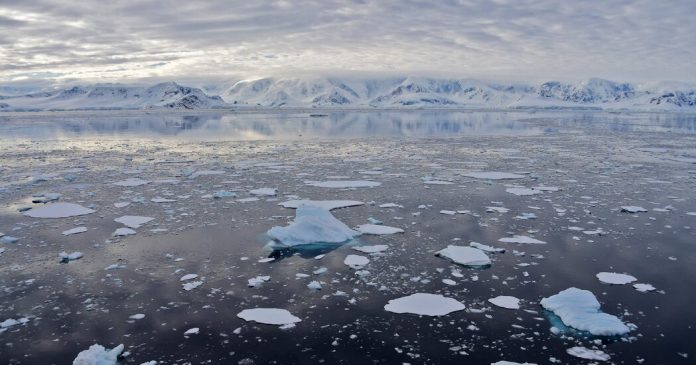Sea ice round Antarctica has reached a report low in 4 a long time of observations, a brand new evaluation of satellite tv for pc pictures reveals.
As of Tuesday, ice lined 750,000 sq. miles across the Antarctic coast, under the earlier report low of 815,000 sq. miles in early March 2017, in keeping with the evaluation by the Nationwide Snow and Ice Knowledge Heart in Boulder, Colo.
“It’s actually unprecedented,” mentioned Marilyn N. Raphael, a professor of geography on the College of California, Los Angeles, who research Antarctic sea ice. Hotter ocean temperatures might have performed a job, she mentioned, “however there are different components that we are going to be engaged on discovering out within the subsequent months.”
Antarctic sea ice extent is very variable from 12 months to 12 months, however total has elevated very barely, on common, because the late Nineteen Seventies, when satellite tv for pc observations started. Against this, sea ice extent within the Arctic, which is warming about thrice as quick as different areas, has decreased by greater than 10 p.c a decade over the identical interval.
The 2 areas are very completely different. The Arctic Ocean covers excessive latitudes, together with the North Pole itself, and is hemmed in by land lots. Within the Southern Hemisphere, Antarctica covers the pole. The Southern Ocean, which surrounds the continent, begins at a lot decrease latitudes and is open to the north.
Whereas fast warming within the Arctic is basically answerable for the shrinking of sea ice there, the impact of local weather change on Antarctic sea ice is much much less clear.
Edward Blanchard-Wrigglesworth, a local weather scientist on the College of Washington, mentioned that many scientists anticipate that world warming will ultimately result in declines in Antarctic sea ice. However proper now, he mentioned, “it’s actually laborious to attach the 2, particularly when it comes to single occasions like this one.”
As an alternative, a posh group of things is at play when it come to Antarctic sea ice. Massive-scale atmospheric patterns, typically occurring removed from the continent, in addition to native ocean currents and winds can all improve or cut back sea-ice protection.
For example, Dr. Blanchard-Wrigglesworth mentioned, some analysis suggests {that a} sturdy El Niño in 2015 and 2016, when sea floor temperatures within the tropical Pacific had been larger than regular, led to sharply decrease sea ice protection in 2016.
Ted Scambos, a senior researcher on the Earth Science and Statement Heart on the College of Colorado, mentioned in an e-mail message that hotter than regular sea-surface temperatures in some areas round Antarctica might have performed a job within the present minimal.
And Dr. Raphael mentioned winds might also have had an impact, particularly within the space of the Amundsen Sea on the continent’s western aspect. A area of low strain air that often develops over the ocean was particularly sturdy this 12 months, she mentioned, and that resulted in stronger winds that will have pushed extra ice farther to the north, into hotter waters the place it could soften sooner.
Whereas total sea ice extent has solely barely elevated because the late Nineteen Seventies, the speed of improve started to speed up in 2000, and ice extent reached a report excessive in 2014. However then one thing surprising occurred, Dr. Raphael mentioned. It dropped drastically over the following three years, reaching the report low in 2017.
Perceive the Newest Information on Local weather Change
A world on fireplace. A United Nations report has concluded that the chance of devastating wildfires around the globe may improve by as much as 57 p.c by the top of the century, as local weather change additional intensifies what the authors of the doc described as a “world wildfire disaster.”
Since then sea ice extent rebounded, Dr. Raphael mentioned, returning to roughly common ranges by 2020.
Usually, she mentioned, ranges would then have continued to be common or above common for a number of years. However the brand new sharp drop this 12 months occurred sooner. “It occurred so shortly,” she mentioned.
“That’s what makes this one uncommon,” she added. After 2017, “the ice went again to regular however didn’t keep that manner.”
Dr. Blanchard-Wrigglesworth mentioned that to know why the ice extent is so low now, researchers should look at how situations might need shifted final 12 months. “I wouldn’t be shocked if we discover out that that is the results of modifications in winds during the last three to 6 months,” he mentioned.
The low sea ice extent has been noticeable within the Weddell Sea, east of the Antarctic Peninsula, which due to its round present retains far more ice from 12 months to 12 months than the opposite components of the Antarctic coast. A gaggle of scientists and explorers encountered comparatively gentle ice situations whereas venturing into the ocean this month looking for the wreck of Endurance, Ernest Shackleton’s ship, which sank throughout an Antarctic expedition in 1915.
This 12 months’s ice extent may dip even decrease, relying on the climate, however ought to quickly begin growing as temperatures start to drop heading into the Antarctic fall and winter. Ice protection reaches a most every year across the finish of September. The typical most over 4 a long time is greater than 7 million sq. miles.
Dr. Blanchard-Wrigglesworth mentioned that occasions like this one and the earlier report low supplied researchers a chance to raised perceive the connection between local weather change and sea ice in Antarctica. “A legitimate new analysis query could be, are these the primary few indications that there’s beginning to be a reversal within the long-term tendencies?” he mentioned.


